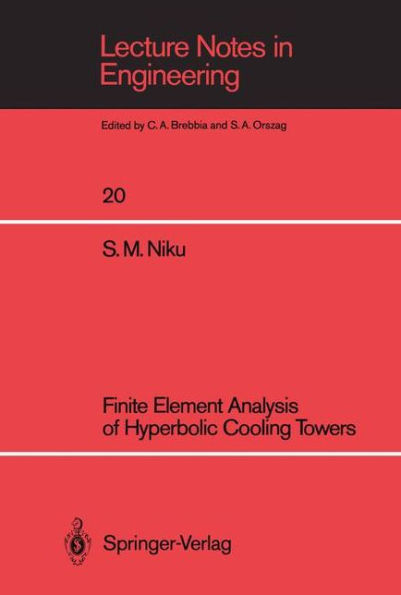Finite Element Analysis of Hyperbolic Cooling Towers
The analysis of thin shells of revolution in general has always occupied an important place in the theory of structures, and recently the problem of hyperbolic cooling towers has attracted many investigators due to the wide use of such shells in industry. Until the early 1960's these towers were of moderate size, probably not exceeding 76m (250ft) height. In this range, the structural safety and stability were not of primary concern because, the minimum wall thickness and reinforcement were sufficient to provide the required safety. It was not necessary to use very rigorous methods to analyse the problem. The analysis involved the following assumptions, i) flexural stresses were ignored (membrane tneory), ii) The geometry of the shell was assumed to be perfect and to be idealised as a set of straight sided conical frusta, and iii) The boundary conditions at the base were taken to be fixed or continuously hinged with full tangential restraint.
"1021133659"
Finite Element Analysis of Hyperbolic Cooling Towers
The analysis of thin shells of revolution in general has always occupied an important place in the theory of structures, and recently the problem of hyperbolic cooling towers has attracted many investigators due to the wide use of such shells in industry. Until the early 1960's these towers were of moderate size, probably not exceeding 76m (250ft) height. In this range, the structural safety and stability were not of primary concern because, the minimum wall thickness and reinforcement were sufficient to provide the required safety. It was not necessary to use very rigorous methods to analyse the problem. The analysis involved the following assumptions, i) flexural stresses were ignored (membrane tneory), ii) The geometry of the shell was assumed to be perfect and to be idealised as a set of straight sided conical frusta, and iii) The boundary conditions at the base were taken to be fixed or continuously hinged with full tangential restraint.
109.99
In Stock
5
1

Finite Element Analysis of Hyperbolic Cooling Towers
216
Finite Element Analysis of Hyperbolic Cooling Towers
216Paperback(Softcover reprint of the original 1st ed. 1986)
$109.99
109.99
In Stock

Product Details
| ISBN-13: | 9783540167389 |
|---|---|
| Publisher: | Springer Berlin Heidelberg |
| Publication date: | 09/15/1986 |
| Series: | Lecture Notes in Engineering , #20 |
| Edition description: | Softcover reprint of the original 1st ed. 1986 |
| Pages: | 216 |
| Product dimensions: | 6.69(w) x 9.61(h) x 0.02(d) |
From the B&N Reads Blog
